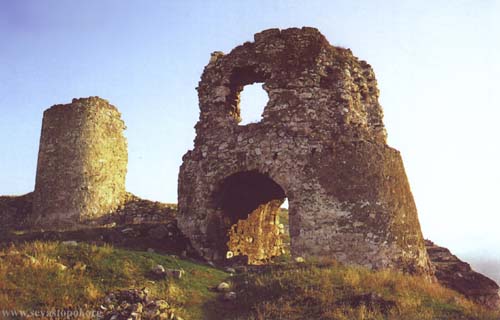| THE 'KALAMITA' FORTRESS | Sevastopol.org |

The fortress "Kalamita" is near Sevastopol, in the
city of "Belokamesk" (previously known as "Incerman").
High
above a road, on a plateau of Monastic rock, rests
ancient fortifications, and in the lower rock
formations rests a quite visible Christian cave
monastery. It is an historical branch - archeological
reserve of Khersonesus - a "Kalamita Fortress".
Kalamita is one of many interesting monuments of the
Crimean middle ages. From the southwest the
fortress is protected by breakages, from the northeast
cut
in a rock, a wall consisting of
three towers with five two-story rectangular
half-towers and one round tower with a travel gate.
The area protected by fortress walls makes up 1500
square meters.
Kalamita was built in the 6th century. Most likely,
the fortress was built for protection of the trade
routes, which started from the steppes of Crimea in
Khersonesus.
Later, in the heyday of the southwest, it was the
Tavrika feudal principality of Feodoro (in 15th
century the Russian and West European sources called
it Mangupskoe). In the mouth of the Black river the
trade port Avlita developed. In 1427 for its
protection, the Mangup prince Aleksey reconstructed
the fortress.
In 1475 principality Feodoro fell victim to Turkish
invasions. Aspiring to strengthen their coastal
positions at the Black and Azov Seas, Turkish
conquerors erected new fortresses and reconstructed
the old ones. They reconstructed Kalamita for the use
of fire-arms. They owned Kalamita up to the end with
the Kuchuk - Kainardzhiyskiy peace contract (1774).
The Turkish had renamed the fortress Incerman, which
means "cave fortress". The name was
not chosen randomly: the rock, on which this fortress
is constructed, is cut up into numerous caves. One of
them had military usage, others were used as economic,
religious and even inhabited premises.
In the Kalamita territory at different times
excavations were carried out, but the monument still
stands awaiting more researchers. In the bottom part
of the Monastic rock and near it the structures were
kept intact. (8th-9th century). Here stands a
Christian monastery which has existed more than
thousand years.
When Byzantian emperors aspired to break the
economic power of church due to struggles in their own
country, icons (beautiful Russian paintings) were kept
in these cave monasteries - which were in the remote
areas of the empire.
By the end of the 18th century, Inkerman's monastery
had become desolated, but in middle of the 19th
century it was
restored. In this period additional churches were
built in this area. The monastery stopped functioning
in 1926, but now its activities have reappeared.
There are two churches cut out of rock. One of them is
based in basilica in the form of an early Christian
temple. There are fragments of fresco remaining to be
seen. The second church, named St. Martin, was cut
nearby. In 1867 the church was restored. Burial vaults
are to be found in the floors and walls and a steep
ladder made of rock reaches from the monastery to the
fortress area.
Here stands a monument to the 25th gunnery division
on ancient grounds wherein there were severe battles
with fascists took place.